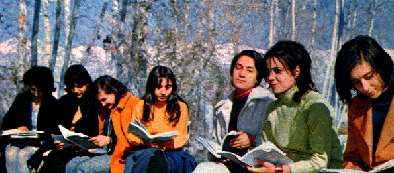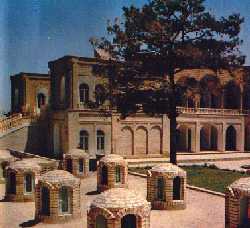


Seen at the campus of Melli University these Iranian students
are pictured on a
background of snowy Alborz Mountains Women enjoyed the same higher
education
as men, and female students as well as professors were to be found in all
faculties.
Many graduated as teachers and more than 40,000 of the country's teaching
staff were women.
Education was given the
highest priority in Iran's development, from two-room schools in remote villages
to research institutes of advanced technology. Three of the points of the
Iran's Development Programme were directly concerned with education. In the
1976-77 Budget total allocations to education amounted to about $2.5 billion,
8.5 per cent of the total Budget and 37 per cent higher than the figure for
the previous year.
The bulk of Iran's educational expenditure was devoted to the primary level, which absorbsed over a quarter of total funds. Included in this heading were not only regular Ministry of Education schools, which numbered over 20,000, but also the activities of the Literacy Corps.
The Literacy Corps, one of the original six points of the Programme, provided for young Iranian high-school graduates eligible for conscription to serve as rural teachers in lieu of regular military service. In the 1976-77 school year, 28,700 Literacy Corpsmen and Corpswomen - were thus employed. There were about 10,000 Literacy Corps schools attended by over half a million pupils. In addition to teaching village children, Literacy Corps teachers carried out a wide range of other duties1 including adult education.
Education in Iran began at the age of five, when children were eligible for a year of free pre-primary education to prepare them for school. Primary education lasted five years and was followed by a "guidance" cycle which covered grades 6, 7 and 8. The guidance cycle included practical sublects like carpentry and metal-working, for girls as well as boys.
Up to grade 8 education was unconditionally free and included a free nutritional programme, in accordance with a decree of the Shahanshah issued in 1974. Although education was not compulsory in Iran, partly because of inadequate facilities in the past, it was expected that all school- age children would enrol for at least the elementary and guidance cycles in the coming years. As a result of studies carried out in 1975 a new system of secondary education, approved by the High Educational Council in August, 1975, was introduced.
The new system reflectedwachanges in the country's social and economic structure, particularly the serious shortages of skilled manpower in industry, agriculture and the services, and the need for better coordination between secondary and higher education. The main principles on which the new system is based were emphasis on moral and religious instruction, ongoing revision of curricula, education in good citizenship and environmental awareness, and the training needs of both society and the individual.
Secondary education as such had been cut to a three-year course, the fourth and final year consisting of pre university studies. Technical and vocational education were diversified and expanded and simple technical course were included in the syllabuses of academic secondary school students a well, so as to make them familiar wit the basic tools and techniques of an industrialized society. Following th practical courses of the guidance cycle, this should have helped eliminate "technological illiteracy", which was all too frequen in the past.
In technical and vocational education the emphasis was on encouraging every student to acquire a few skills rather than just one, since technological developments required polyvalent technicians capable of carrying out new job functions after a short intensive in-service training course. Parallel with this was the decision to delay specialization and include similar fundamental courses in the first and even the second year of each branch of secondary education, thus helping students to select the course most suited to their talents and interests.
Education beyond the eighth grade, and indeed right through the higher educational system as well, would be free, provided students sign a service agreement to work for the Government, or in a specified job, for the same number of years as their years of free education beyond grade 8. The conditions of such employment would be normal. Iran's higher educational system consisted of both public and private institutions, and included universities, other degree-giving establishments, and institutions affiliated to Government agencies.
The oldest university is the University of Tehran, founded by Reza Shah in 1934, which became the first modern university in Iran, although in the nineteenth century a limited range of post~econdary education had been available at the Dar- ol-Fonun, now a high school.
Ironically, Iran had once been a world centre of higher education, and the famous Gondi Shapur medical college was established in the third century A.D. With the advent of Islam this tradition was revived, particularly by Nezam-ol-Molk, the Persian vizir of the Seljuq Sultans, who in the eleventh century established a series of colleges named after him Nezamiyehs. While theology was the principal subject taught, philosophy, the humanities, astronomy and medicine were also on the curriculum.
 Tehran University
and the Higher Institute of Teacher Training, founded in 1924 also by Reza
Shah the Great, remained the only institutions of higher education until
1947, when Tabriz University was established. In 1975 there were 10 full
universities functioning (Tehran, Tabriz, Pahlavi, Ferdowsi, Esfahan, Gondi
Shapur, Melli, Aryamehr, Teacher Training, Education Corps) and four more
opened in the 1976-77 academic year (Baluchestan, Kerman
College seen left, Gilan Physical Education and Kermanshah). By
1978 five more (Free, Bu Ah Sina, Reza Shah the Great, Gilan and Farabi)
at the functioning stage. The Free University, modelled on the U.K.'s
Open University, made extensive use of television and other audio-visual
aids to make higher education available in remote areas and to part-time
students.
Tehran University
and the Higher Institute of Teacher Training, founded in 1924 also by Reza
Shah the Great, remained the only institutions of higher education until
1947, when Tabriz University was established. In 1975 there were 10 full
universities functioning (Tehran, Tabriz, Pahlavi, Ferdowsi, Esfahan, Gondi
Shapur, Melli, Aryamehr, Teacher Training, Education Corps) and four more
opened in the 1976-77 academic year (Baluchestan, Kerman
College seen left, Gilan Physical Education and Kermanshah). By
1978 five more (Free, Bu Ah Sina, Reza Shah the Great, Gilan and Farabi)
at the functioning stage. The Free University, modelled on the U.K.'s
Open University, made extensive use of television and other audio-visual
aids to make higher education available in remote areas and to part-time
students.
In addition to the universities proper there were some 150 other institutions of higher education, including 87 affiliated to such bodies as the Ministry of Health, the Ministry of Agriculture and the National Iranian Oil Company, which met the manpower needs of specific sectors or industries, and 40 private institutes that provided tuition in languages, commerce, computer sciences, management, banking and other subjects.With such an ambitious educational expansion programme there was obviously a major need for teacher training, and over nine per cent of the total education budget was allocated to this activity. In the 1976-77 academic year alone, the capacity of teacher training colleges was expanded from 18,000 to 26,500 primary school teachers, and from 13,500 to 17,500 guidance level teachers. There was increased emphasis, too, on the training of technical school teachers, including the use of ILO training facilities in Italy and specialized centres elsewhere.